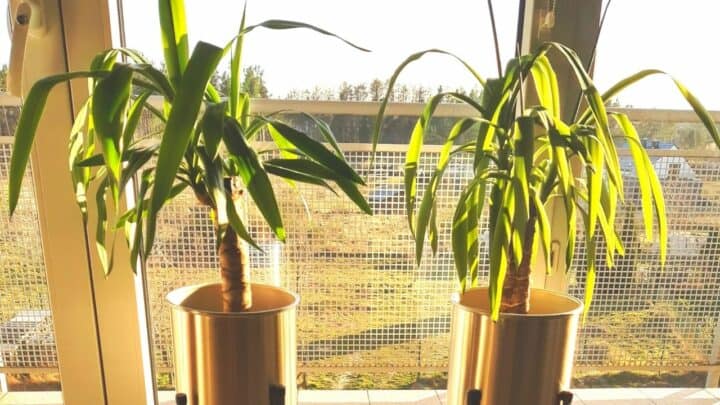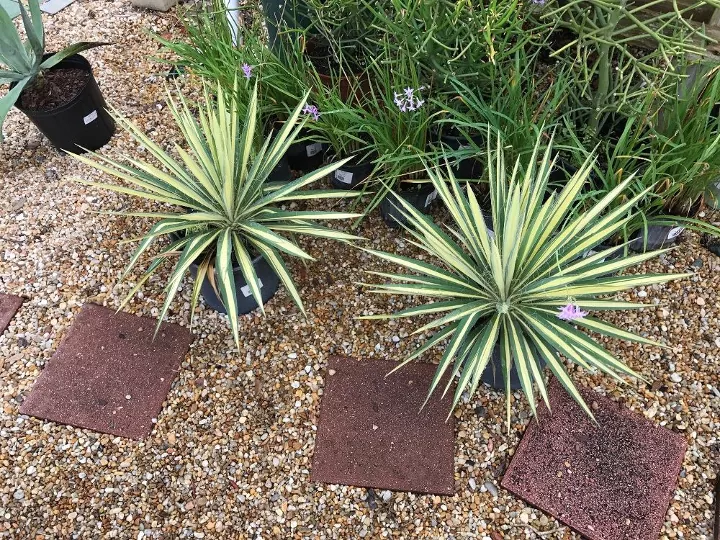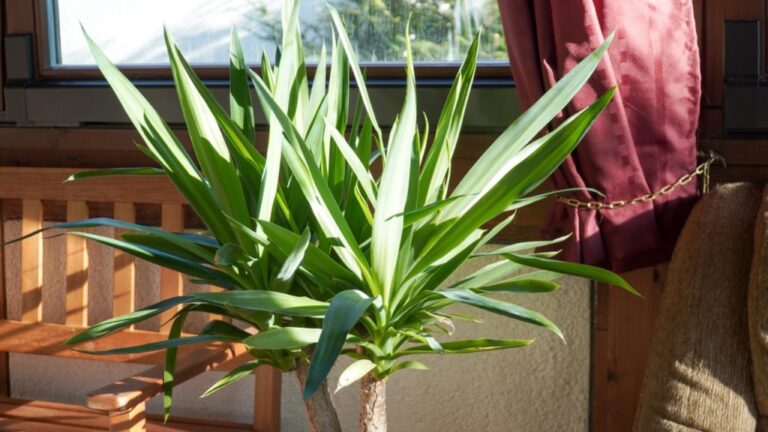Yucca plants can droop for various reasons, but it’s essential to figure out why to help them recover. Overwatering, which leads to root rot, and underwatering, causing dehydration, are common culprits.
Yuccas prefer well-draining soil, and you should let the soil dry a bit between watering. Place your yucca in a spot with bright, indirect light, as too much direct sun can make it droop.
Watch for pests like spider mites and diseases that weaken the plant. Yuccas need the right nutrients, so use a balanced succulent fertilizer. Check the roots for problems, and consider repeating if necessary. Maintain a consistent temperature within their preferred range, avoiding extreme conditions.
What causes yucca plants to droop?

Yucca plants can droop for various reasons, and it’s essential to identify the underlying cause to address the issue properly.
Watering Issues
Overwatering and Root Rot: Overwatering is a common cause of yucca drooping. When the soil is consistently waterlogged, the roots suffocate and can develop root rot, a fungal disease that causes them to decay.
Signs of overwatering include yellowing or wilting leaves. To prevent this, allow the soil to dry out partially between waterings. When you do water, ensure it’s a thorough but infrequent soak.
Underwatering and Dehydration: Yuccas are drought-tolerant, but prolonged dryness can cause them to droop. Underwatering results in dehydration, and the plant’s leaves may become limp and shriveled.
To prevent this, water your yucca when the top few inches of soil are dry, but don’t let it become bone dry. Adequate watering helps the plant maintain its turgidity.
Importance of Well-Draining Soil and Proper Watering Frequency: Yuccas thrive in well-draining soil, such as cactus mix. It’s essential to choose a pot with drainage holes and to avoid letting your yucca sit in standing water.
Proper watering frequency is crucial to maintaining soil moisture balance and preventing root issues.
Lighting Conditions
The Impact of Incorrect Lighting on Yucca Health: Yuccas require the right balance of light. Too little light can lead to elongated, weak growth and eventually drooping. On the other hand, too much direct sunlight can scorch the leaves.
Yuccas do best in bright, indirect light. Place them near a window with filtered sunlight or use sheer curtains to diffuse intense rays.
The Need for Bright, Indirect Light: Yuccas are not shade plants, and they depend on adequate light for photosynthesis.
Bright, indirect light provides the ideal conditions for their growth. Be mindful of their placement to ensure they receive the right amount of light for healthy development.
Pests and Diseases
Identification of Common Pests (e.g., Spider Mites): Yuccas can fall victim to pests such as spider mites, scale insects, and mealybugs. Spider mites are particularly troublesome, as they are tiny and can go unnoticed until they’ve done significant damage.
In addition, inspect the leaves regularly for tiny webbing and stippling on the surface. Address pest infestations promptly with appropriate treatments, such as insecticidal soap.
The Weakening Effect of Diseases: Yuccas are susceptible to diseases like leaf spot and fungal infections.
Moreover, these diseases can weaken the plant, leading to drooping leaves and reduced overall health. Proper sanitation, well-draining soil, and good air circulation can help prevent disease issues.
Nutrient Deficiencies
Yuccas require certain nutrients for healthy growth. Nutrient deficiencies, especially those of essential minerals like nitrogen, phosphorus, and potassium, can lead to drooping, yellowing, or stunted growth. A lack of nutrients weakens the plant’s ability to maintain its structure and health.
To address nutrient deficiencies, use a balanced succulent or cactus fertilizer. These fertilizers are formulated to provide the necessary nutrients while preventing over-fertilization, which can harm the plant. Follow the recommended feeding schedule, typically during the growing season in spring and early summer.
Root and Pot Issues
Inspecting Roots for Problems: Regularly check the roots for signs of trouble. Healthy roots are firm and white, while unhealthy roots may be brown, mushy, or have a foul odor.
However, if you identify root problems, trim away the affected parts, and ensure proper drainage to prevent future issues.
Yuccas may outgrow their pots, become root-bound, or experience soil depletion over time. If your yucca shows signs of stress and you’ve ruled out other issues, consider repotting it in a slightly larger container with fresh, well-draining soil. Repotting can provide the plant with a fresh start and room for growth.
How do environmental factors affect yucca plant health?
Environmental factors play a crucial role in the health and well-being of yucca plants. Yuccas are adapted to specific conditions in their native habitats, and when grown in different environments, they can be susceptible to various issues.
Temperature Considerations
Maintaining an Ideal Temperature Range: Yuccas thrive within a specific temperature range. They prefer warm temperatures and can tolerate a broad spectrum, typically between 60°F to 80°F (15°C to 27°C).
Maintaining the temperature within this range is crucial for their well-being. When the temperature is too cold, especially below 50°F (10°C), yuccas can become stressed and droop.
On the other hand, extremely high temperatures, above 100°F (38°C), can also lead to wilting and drooping as the plant struggles to conserve water. To keep your yucca healthy, ensure it’s placed in an environment with a stable and appropriate temperature.
Avoiding Extreme Temperature Conditions: Yuccas are sensitive to sudden temperature fluctuations. Avoid placing them near drafts or vents, as exposure to cold drafts can cause shock and drooping.
Similarly, direct exposure to hot radiators or heaters can lead to drying out and drooping. Shield your yucca from extreme temperature conditions by placing it in a location with consistent, indirect temperature, and avoid rapid changes in its environment.
Pot Size and Pruning
Effects of Outgrowing the Pot: Yuccas can outgrow their pots over time, and this can result in root congestion. When a yucca becomes root-bound, it can face several issues. The roots may not have enough space to spread and absorb water and nutrients effectively, which can lead to drooping as the plant struggles to sustain itself.
To remedy this, consider repotting your yucca into a slightly larger container. Transplanting provides the plant with more room for root development and can rejuvenate its health.
The Importance of Cautious Pruning to Prevent Shock: Pruning yuccas can be a helpful maintenance practice, but it should be done with care. Overly aggressive pruning can shock the plant, causing it to droop and lose vigor. When you prune, focus on removing dead or damaged leaves and keep overall trimming to a minimum.
Typically, it’s best to prune yuccas in the spring or early summer, just before the growing season begins. By carefully managing pruning and repotting, you can help your yucca maintain its structure and health without causing unnecessary stress.
What are the remedies and care for a drooping yucca plant?

If your yucca plant is drooping, it’s essential to determine the underlying cause and then take appropriate remedial action to address the issue.
Correcting the Causes
Steps to Address Overwatering and Underwatering: For overwatering, the first step is to allow the soil to dry out. Remove the plant from its pot if necessary to assess the root health. Prune away any rotting roots and let the remaining healthy roots air dry.
For underwatering, give your yucca a thorough, deep watering. Ensure the water penetrates the root zone and allows any excess to drain from the pot. Then, adjust your watering schedule to prevent future dehydration.
Adjusting Lighting Conditions: If your yucca isn’t receiving enough light, move it to a spot with brighter, indirect light. Yuccas appreciate approximately 4-6 hours of indirect sunlight per day.
In addition, if the plant is exposed to too much direct sunlight, shift it to a location with filtered sunlight or provide some shade during the hottest parts of the day. A sheer curtain can help diffuse intense sunlight.
Treating Pests and Diseases: To combat common pests like spider mites, you can use insecticidal soap or neem oil. Apply these treatments as directed on the product label. Isolate infected plants to prevent the spread of pests.
For diseases, prune away affected leaves and improve air circulation around the plant. If a severe infection persists, you might need to consider a fungicide. Always follow the instructions on the chosen treatment.
Providing Proper Nutrients: If nutrient deficiencies are causing drooping, apply a balanced succulent fertilizer following the recommended dosage. Typically, you should fertilize yuccas during the growing season (spring to early summer) when they actively grow.
Monitor the plant’s response to the fertilizer, and do not over-fertilize, as this can lead to other problems. A balanced fertilizer provides essential macronutrients like nitrogen, phosphorus, and potassium.
Root and Pot Care
Proper Root Care and Repotting if Necessary: If you’ve identified root issues, carefully trim away damaged or rotting roots using clean, sharp scissors or pruning shears. Allow the trimmed roots to air dry before repotting.
Moreover, choose a pot that is only slightly larger than the current one to avoid overpotting. Fill the new pot with fresh, well-draining soil, and replant your yucca, ensuring it sits at the same depth as before.
Pot Size Considerations: Yuccas prefer to be a bit root-bound, so select a pot that is about 1-2 inches larger in diameter than the current one.
Furthermore, this provides enough space for root growth without overwhelming the plant. Make sure the new pot has drainage holes to prevent waterlogging and root issues.
FAQ’s
How do you keep a yucca plant upright?
Support a drooping yucca with stakes or ties to help it stand upright. Ensure proper watering and lighting to promote strong growth.
What does an underwatered yucca look like?
An underwatered yucca may display drooping or yellowing leaves, dry and brittle foliage, and slowed growth.
Do yucca plants need full sun?
Yucca plants thrive in bright, indirect sunlight. While they can tolerate full sun, it’s important to protect them from scorching in intense sunlight.
Can yucca survive in low light?
Yuccas can survive in low light but won’t thrive. They may become leggy, with stretched-out growth, and are more susceptible to issues like leaf yellowing.
Will my yucca grow back?
Yuccas can regrow from the center or produce new shoots if the crown is healthy, even if some leaves are damaged or pruned. Pruning can also encourage new growth.
What happens if you overwater a yucca plant?
Overwatering yucca can lead to root rot, causing drooping, yellowing, and mushy roots. Ensure well-draining soil and allow it to dry between waterings to prevent this issue.
Final Words
In conclusion, taking care of your yucca plant doesn’t have to be complicated. If you notice it drooping, remember to first identify the root cause, whether it’s overwatering, underwatering, light issues, pests, or other factors.
Once you’ve pinpointed the problem, there are simple steps you can take to nurse your yucca back to health.
Adjust the watering schedule, provide the right amount of light, and treat any pests or diseases you find. Don’t forget to feed your yucca with the proper nutrients, too. If you suspect root or pot issues, take a closer look and consider repotting if necessary.

